
Environmental Protection & Occupational Safety
Climate Change and Carbon Management
USI integrates the concept of ecologically sustainable development with company's managerial decision-making and operation management. The board of directors and the executives assume management responsibility and take the opinions of stakeholders as reference to formulate the corresponding management strategy. Through the continuous promotion of management systems ISO 14001, ISO 50001, and ISO 14064-1:2018, we have improved and reduced environmental impact of our operations and hereby make a public disclosure about USI's environmental information for the implementation of corporate environmental responsibility.
The global warming caused by greenhouse gas emissions over the years has exposed the world economy to significant risks and has threatened many businesses around the world. In response to international initiatives and our Low-Carbon Strategy, USI adopted the TCFD framework and discloses the risks and opportunities brought by climate change, demonstrating corporate responsibility and strategy to allocate capital more reasonably and effectively to achieve the vision of low carbon economic transformation.
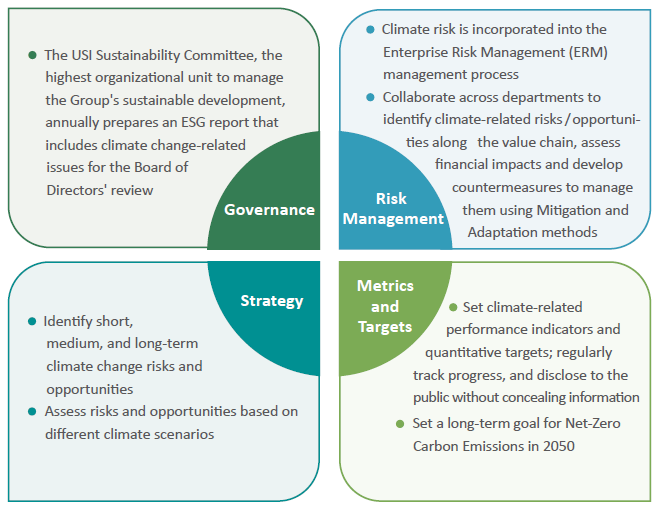
According to the analysis of the Climate Change Risk and Opportunity Matrix, there are three transition risks, three physical risks and three transformation opportunities, among which the high risk of USI is the demand for green products from customers.
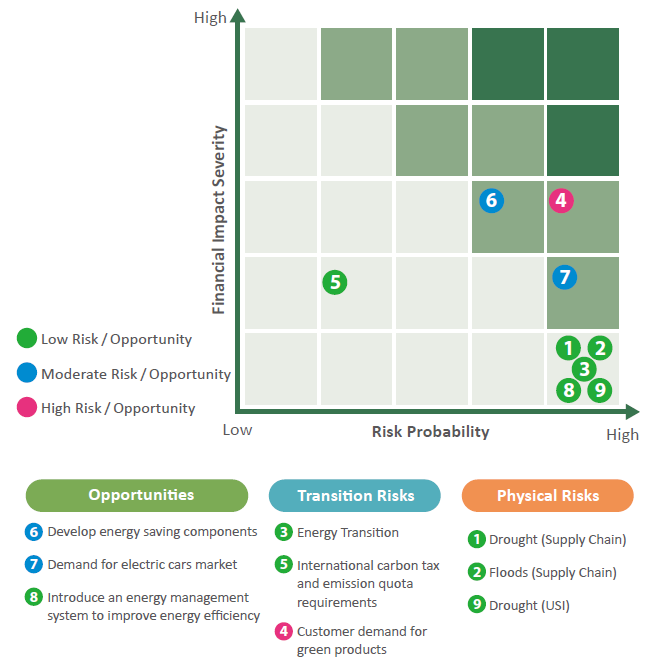
We announced our goal of achieving net zero carbon emissions by 2050 and continues to implement climate change and energy management, water management, waste management and air pollution prevention to help customers produce energy-saving and carbon-reducing products. For the first time, we are presenting our efforts and results in response to climate change through a systematic disclosure framework, further raising awareness of climate crisis, formulating relevant mitigation plans and measures, accelerating the implementation of risk control and climate change mitigation actions, strengthening our operating sustainability management capabilities, and moving towards sustainable corporate development.
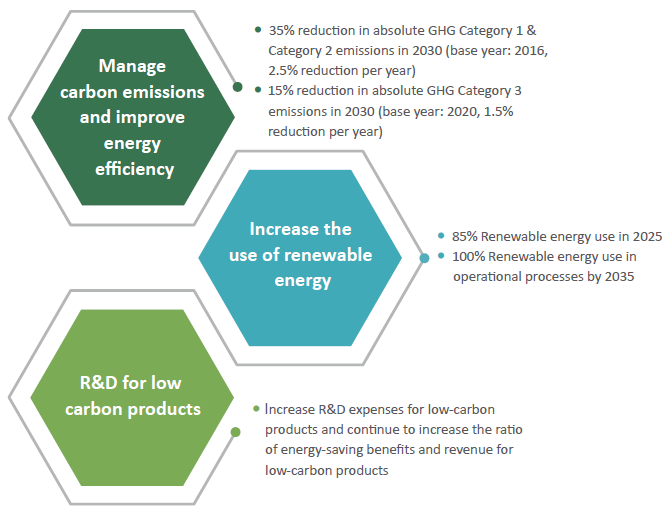
USI's total GHG emissions in 2021 were 206,131.55 metric tonnes of CO2e (Category 1 & Category 2), an increase of 15,103.32 metric tonnes of CO2e from 2020, and our GHG emissions intensity was 4.13 metric tonnes of CO2e, an increase of 0.11 metric tonnes of CO2e from 2020.
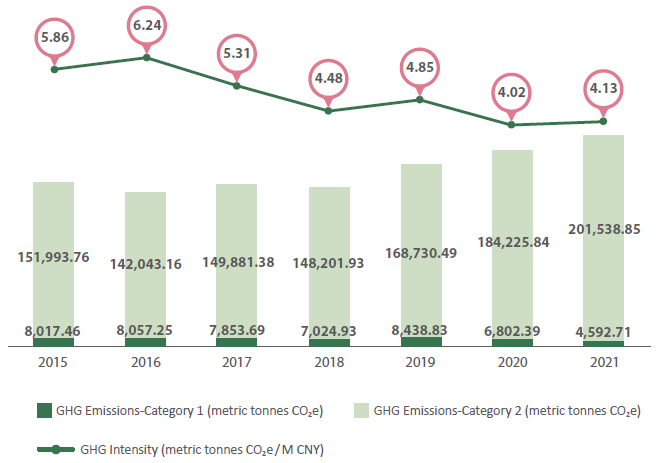
|
Category |
Description |
Greenhouse Gas Emissions |
|
Category 3 |
Indirect greenhouse gas emissions from transportation |
103,140.41 |
|
|
Emissions from upstream transportation and distribution of goods |
48,016.13 |
|
|
Emissions from downstream transportation and distribution of goods |
44,545.17 |
|
|
Emissions from employee commuting |
10,364.53 |
|
|
Emissions from business travel |
214.58 |
|
Category 4 |
Indirect greenhouse gas emissions from products used by the organization |
12,877,738.29 |
|
|
Emissions from goods purchased |
12,843,600.91 |
|
|
Emissions from capital goods |
30,571.58 |
|
|
Emissions from solid and liquid waste treatment |
1,230.79 |
|
|
Emissions from the use of assets |
2,335.01 |
|
Total |
12,980,878.70 |
|
In the green-house gas emissions, power loss shares about 97.8% in USI. The key to reducing carbon emission is to save power, making maximum efforts for electricity efficiency. The total energy consumption of USI in 2021 was 986,633.2 gigajoules, an increase of 37,706.9 gigajoules from 2020. Based on the turnover, the energy consumption per million CNY in 2021 decreased by 0.002 gigajoules.
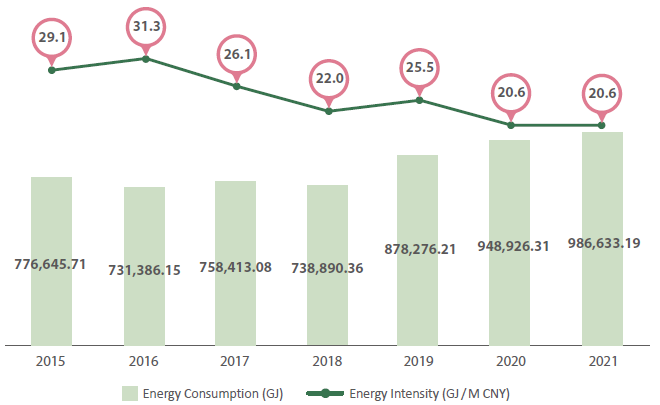
|
Category |
Direct Energy Consumption |
Indirect Energy Consumption |
Total Energy Consumption |
||
|
Diesel |
Gasoline |
Natural Gas |
Electricity |
||
|
2021 |
1,335.80 |
2,575.20 |
34,238.98 |
948,483.21 |
986,633.19 |
|
2020 |
1,393.59 |
2,523.89 |
74,103.64 |
870,905.19 |
948,926.31 |
|
2019 |
1,065.38 |
3,572.89 |
103,881.07 |
769,756.87 |
878,276.21 |
|
2018 |
639.08 |
4,011.47 |
76,708.71 |
657,531.10 |
738,890.36 |
USI actively responds to the call for renewable energy use. We purchased 222,319 MWh International REC (I-REC, the registration authority is I-REC Registry) in 2022 to offset CO2 emitted by traditional power in 2021 (the annual electricity use for Zhangjiang, Jinqiao, Shenzhen, Kunshan Facilities were all offset, and 31% of Mexico Facility's electricity was offset). Low-carbon products produced in facilities using renewable energy accounts for 69.93% of USI's annual revenue.
|
Category |
Item |
Category 1 |
Category 2 |
Total |
|---|---|---|---|---|
|
Location-based |
GHG Emissions (Metric tonnes CO2e) |
4,592.71 |
201,538.85 |
206,131.56 |
|
Percentage (%) |
2 |
98 |
100 |
|
|
Market-based |
GHG Emissions (Metric tonnes CO2e) |
4,592.71 |
26,617.41 |
31,210.12 |
|
Percentage (%) |
15 |
85 |
100 |


